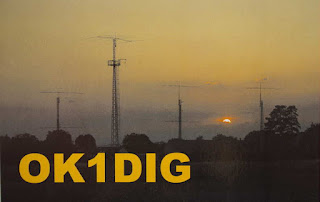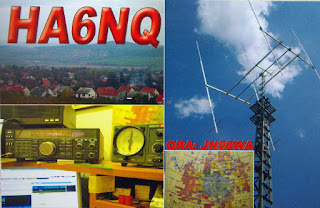Posts Tagged ‘JT9’
 May Moonbounce / More 6m WSJT Observations
May Moonbounce / More 6m WSJT Observations
 Late May's EME activity seemed poorer and less active than the previous month of northern declination moonrises.
Late May's EME activity seemed poorer and less active than the previous month of northern declination moonrises.Unlike winter's northern moonrises, the summer ones occur close to 'new moon' time and for a few days on the much favored northern path, the moon is too close to the sun, resulting in lower activity and higher noise. As well, with the warmer summer weather, outdoor projects or other summer activities often take priority over ham radio operations at this time of the year.
Nevertheless, I did manage to work five stations with my small station, and added four 'new initials', bringing my total unique-station QSO total to 105 ... it seems there are still plenty of folks out there that I have yet to work!
- VE1KG
- OK1DIX #102
- S53K #103
- IK1UWL #104
- OZ1CT #105
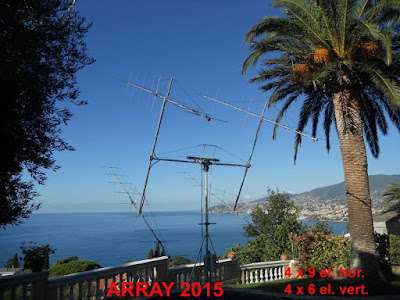 |
| IK1UWL's 4 x 9el cross-polarized array |
 |
| S53K's 4 x 11el array |
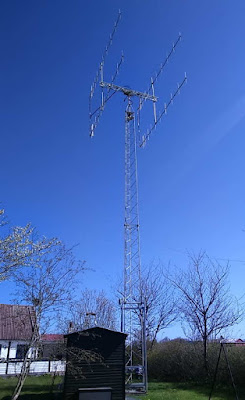 |
| OZ1CT's 4 x 10el cross-polarized array |
Latest Incoming EME QSLs:
With the summer Sporadic-E season now in full swing, I've had the opportunity to make some early observations regarding the growing use of the weak-signal digital modes. It seems my previous suspicions about the migration from traditional modes to the digital modes is occurring even more rapidly and in much larger numbers than I had expected. Almost all early activity has been concentrated on both JT65 and JT9 modes and most of the chatter on the ON4KST 6m chat page centers around these digital modes.
So far this season I have heard much more DX on JT65 than on CW or SSB, including two stations in Europe on Tuesday (EI4DQ and F5LNU). It seems that many QSO's are taking place with signals that are usually too weak to be heard by ear (~ -16db or weaker) and if listening for CW signals, the band would appear to be pretty much dead. With no full-blown openings to Europe yet, I just wonder if stations will stay put on JT65 or move to the much faster CW mode for making quick contacts when the propagation allows?
Making JT65 contacts is not a particularly fast process, with most QSOs taking a minimum of four minutes, if both operators are well acquainted with the procedures ... longer if not or if QRM or propagation throws a spanner into the works. Some of the newer JT9 sub modes allow for quicker exchanges as does the much less sensitive MSK144 mode but with so many options now available, it's often difficult to get everyone on the same mode or at least figure out what mode you are seeing!
I can see the advantages of using these modes when conditions will not support CW but will still allow digital decodes. If the normal 'weak signal window' can be sustained for a much longer time period than the usually short-lived audible CW-level window, perhaps more stations could actually be worked on these modes even though the QSO rate is much slower. But I still think that many easy CW QSO's will inevitably be missed when operators are watching their digital waterfalls and ignoring the CW end of the band ... of course, if everyone is doing that, then there will be nothing to be heard on CW, even though conditions may well support good signals.
It's a strange new situation and I'm probably not the only one that may be worried about the negative effects of the new weak-signal modes on 6m ... time will tell, but for me, if things keep going along this path, much of 6m's magic may be gone along with it.
Some other initial observations are:
- maybe it's possible to work more DX on weak signal mode, even though it is slower, because of the possibly longer propagation window at sub audible signal levels? ... ie. on a seemingly 'dead band' by ear.
- many are using the wrong sequence when calling for EU or JA. Folks need to pay attention to what sequence the DX is using!
- if your neighbours are running on even or odd sequence, then it might be neighbourly to also use the same sequence to avoid causing disruptive QRM. This seems to go south fast, once the band breaks wide open and it seems like 'every man for himself' ... not unlike 50.125!
- there are too many weak-signal modes and it would be advantageous to settle on a 'standard' mode for 6m DX. It seems as though many are wasting valuable time either switching modes or trying to figure out what mode they are seeing but not decoding! On long haul 6m Es, things change too quickly to waste time.
- there are still a lot of over-driven signals or signals with 60Hz components causing double decodes +/- 60Hz from their main signals.
 Digital Revolution Or Evolution?
Digital Revolution Or Evolution?
 |
| courtesy: KD0WTE |
A recent reflector posting tended to confirm a rather intriguing trend that I have also been noticing over the past few years.
The poster lamented the fact that he often found very few or even no CW / SSB signals on the HF bands while at the same time seeing lots of activity throughout the digital portion of the bands.
It does seem like there is far less CW and phone activity on the HF bands now, than there was a few years ago and there is no question that digital activity has soared. Whether it's RTTY, PSK31, JT65, WSPR, JT9 or others, these digital signals are always prominent and, band plan or not, are slowly migrating further in the band as activity increases ... but is this the reason for the decline of traditional modes?
The digital weak-signal modes make these extremely popular for a number of reasons. Nowadays, many amateurs are living in antenna-restricted communities and are forced to develop smaller, lower and less effective stealthy antenna systems if they wish to get on the air and make contacts. Most of these modes perform well with minimal amounts of power and are capable of hearing well into the noise ... and unless you live out in the country, with well-separated neighbours, we all know that noise is increasing at horrific levels almost everywhere. These two factors alone might well explain much of the growth in digital activity.
Licencing requirements have also been slowly evolving and today, getting a ticket is much easier than it was several decades ago ... and in many cases, without the requirements of knowing anything about CW. Every month, North Americans see a large number of new amateurs, many with no code skills and possibly not much interest in acquiring them. From my own local observations, most of these new amateurs usually head straight to FM on the VHF/UHF bands and have little knowledge of or interest in HF radio. These factors must also play into the demise of activity on the traditional HF modes as well.
We also shouldn't overlook the influence that Old Sol is having on our HF bands as well. Solar Cycle 24 (begun in 2008) has been one of the poorest on record and continues to generate month after month of terribly poor HF propagation. As a young SWL who listened in Cycle 19, (the largest on record), I can vouch for the relationship between HF activity and good propagation. Those were amazing days, when 20 and 15m would stay open all night long ... even 10m would often still be open with F2 propagation at midnight towards VK and ZL! Everyday, month after month, the bands were simply bulging with activity, from end to end ... high solar flux numbers bring high activity numbers and we are now experiencing the downside effects of what happens when the sun dreadfully underperforms. The only exception to band-bulging activity today seems to be limited to major contest weekends only. Where these people go the rest of the time is a mystery.
There are surely other reasons as well for the gradual decline of traditional-mode HF activity, including the fact that the general ham population is getting older. Large numbers of stations are simply 'going away' as interest or opportunity declines and as more of the aging traditional-mode ops go 'SK'. I know of several hams that have just given-up because of insurmountable increases in their local noise floors. Our new and usually younger hams, have largely grown up in the 'digital age' and for those that do find themselves exploring the HF bands without CW skills, might logically settle into the digital modes first.
Things are changing quickly, of that there is no doubt. Last summer, on 50mHz, I noticed a large increase in the number of dedicated CW operators moving to JT65 and JT9 during openings and this summer has already seen another huge migration from one mode to the other.
Although this year's Sporadic-E season is just getting started, I have already heard many more countries on JT65 than I have on the traditional modes (Japan, Philippines, China, Formosa, Alaska, Venezuela, Cuba, Brazil). Yesterday I listened to a PY calling CQ on CW for some length, with no takers, while it seemed most of the usual west coast ops were watching the digital band. I fear that many good QSO possibilities will be lost as more stations switch to the much slower digital modes ... on 6m, many of the openings last for a very short time making CW or SSB the quickest way to complete a contact. The other problem I notice this summer is that there are several JT sub-modes and it is often difficult or impossible to figure out which mode is being used let alone having the time to switch to the other mode before signals are gone ... perhaps a case of having too much of a 'good thing'? Hopefully one mode will emerge as the '6m standard' so all are on the same page.
What will be the long-term outcome of these changes remains to be seen but I suspect we'll see more and more of our HF CW and SSB spectrum space gradually shrinking to make room for more digital activity, likely to become the dominant modes eventually.
As a life-time, almost exclusive CW operator since age 15, I find this somewhat disheartening but must admit that over the past few years, I have found my own level of weak-signal digital activity increasing by leaps and bounds. These are powerful, capable modes and offer amateurs new and exciting challenges from VLF to nanowaves. Are they as exciting as my much-loved CW? Ask me in a couple of years!
 Digital Revolution Or Evolution?
Digital Revolution Or Evolution?
 |
| courtesy: KD0WTE |
A recent reflector posting tended to confirm a rather intriguing trend that I have also been noticing over the past few years.
The poster lamented the fact that he often found very few or even no CW / SSB signals on the HF bands while at the same time seeing lots of activity throughout the digital portion of the bands.
It does seem like there is far less CW and phone activity on the HF bands now, than there was a few years ago and there is no question that digital activity has soared. Whether it's RTTY, PSK31, JT65, WSPR, JT9 or others, these digital signals are always prominent and, band plan or not, are slowly migrating further in the band as activity increases ... but is this the reason for the decline of traditional modes?
The digital weak-signal modes make these extremely popular for a number of reasons. Nowadays, many amateurs are living in antenna-restricted communities and are forced to develop smaller, lower and less effective stealthy antenna systems if they wish to get on the air and make contacts. Most of these modes perform well with minimal amounts of power and are capable of hearing well into the noise ... and unless you live out in the country, with well-separated neighbours, we all know that noise is increasing at horrific levels almost everywhere. These two factors alone might well explain much of the growth in digital activity.
Licencing requirements have also been slowly evolving and today, getting a ticket is much easier than it was several decades ago ... and in many cases, without the requirements of knowing anything about CW. Every month, North Americans see a large number of new amateurs, many with no code skills and possibly not much interest in acquiring them. From my own local observations, most of these new amateurs usually head straight to FM on the VHF/UHF bands and have little knowledge of or interest in HF radio. These factors must also play into the demise of activity on the traditional HF modes as well.
We also shouldn't overlook the influence that Old Sol is having on our HF bands as well. Solar Cycle 24 (begun in 2008) has been one of the poorest on record and continues to generate month after month of terribly poor HF propagation. As a young SWL who listened in Cycle 19, (the largest on record), I can vouch for the relationship between HF activity and good propagation. Those were amazing days, when 20 and 15m would stay open all night long ... even 10m would often still be open with F2 propagation at midnight towards VK and ZL! Everyday, month after month, the bands were simply bulging with activity, from end to end ... high solar flux numbers bring high activity numbers and we are now experiencing the downside effects of what happens when the sun dreadfully underperforms. The only exception to band-bulging activity today seems to be limited to major contest weekends only. Where these people go the rest of the time is a mystery.
There are surely other reasons as well for the gradual decline of traditional-mode HF activity, including the fact that the general ham population is getting older. Large numbers of stations are simply 'going away' as interest or opportunity declines and as more of the aging traditional-mode ops go 'SK'. I know of several hams that have just given-up because of insurmountable increases in their local noise floors. Our new and usually younger hams, have largely grown up in the 'digital age' and for those that do find themselves exploring the HF bands without CW skills, might logically settle into the digital modes first.
Things are changing quickly, of that there is no doubt. Last summer, on 50MHz, I noticed a large increase in the number of dedicated CW operators moving to JT65 and JT9 during openings and this summer has already seen another huge migration from one mode to the other.
Although this year's Sporadic-E season is just getting started, I have already heard many more countries on JT65 than I have on the traditional modes (Japan, Philippines, China, Formosa, Alaska, Venezuela, Cuba, Brazil). Yesterday I listened to a PY calling CQ on CW for some length, with no takers, while it seemed most of the usual west coast ops were watching the digital band. I fear that many good QSO possibilities will be lost as more stations switch to the much slower digital modes ... on 6m, many of the openings last for a very short time making CW or SSB the quickest way to complete a contact. The other problem I notice this summer is that there are several JT sub-modes and it is often difficult or impossible to figure out which mode is being used let alone having the time to switch to the other mode before signals are gone ... perhaps a case of having too much of a 'good thing'? Hopefully one mode will emerge as the '6m standard' so all are on the same page.
What will be the long-term outcome of these changes remains to be seen but I suspect we'll see more and more of our HF CW and SSB spectrum space gradually shrinking to make room for more digital activity, likely to become the dominant modes eventually.
As a life-time, almost exclusive CW operator since age 15, I find this somewhat disheartening but must admit that over the past few years, I have found my own level of weak-signal digital activity increasing by leaps and bounds. These are powerful, capable modes and offer amateurs new and exciting challenges from VLF to nanowaves. Are they as exciting as my much-loved CW? Ask me in a couple of years!
 ZF1 – VE7 On 630m
ZF1 – VE7 On 630m

Early last night ZF1EJ (Eden) and I were able to easily complete a two way JT9 QSO on 630m ... 475.300 kHz to be more exact.
This was Eden's first 630m JT9 QSO as well as the first ever 630m QSO between Canada and the Cayman Islands. The contact was completed shortly between 8:15 and 8:30 PM local time. The contact attempt was initiated via the ON4KST 2200m / 630m chat page after I had decoded Eden's signal shortly before 7 PM local time ... the first time I have seen his signal so early in the evening.
Eden was using a VK4YB Monitor Sensors Transverter and a newly deployed transmitting antenna described below in the KB5NJD Daily 630m Report:
"This is how the antenna is setup:- It is a tophat vertical, the tophat is 65’ 6” long and about 80’ above ground, the vertical is 74’ 6”, There are 4 radials 10’ above ground, each 128’ 6” long. The antenna is made of #10, stranded insulated wire. The tophat is strung between two towers and is side on about 45 deg. The tuner was built by Ron and Ward a few month ago and shipped down to me. Just found the time to set it up recently. The SWR is 1.1-1 and I am using a Monitor Sensors Transverter built by Roger, VK4YB. Output to antenna 22 watts."
The only change to the above report was Eden's e-mail follow-up indicating that his power output during our QSO was 32 watts ... conditions must have been even better than I thought.
 |
| JT-9 Screen At VE7SL |
With an even newer JT-9A mode now promising a 2db improvement, making contacts should be even easier. Once the USA gets access to 630m, it is clear that Eden will be a popular target for most North American stations!
 ZF1 – VE7 On 630m
ZF1 – VE7 On 630m

Early last night ZF1EJ (Eden) and I were able to easily complete a two way JT9 QSO on 630m ... 475.300 kHz to be more exact.
This was Eden's first 630m JT9 QSO as well as the first ever 630m QSO between Canada and the Cayman Islands. The contact was completed shortly between 8:15 and 8:30 PM local time. The contact attempt was initiated via the ON4KST 2200m / 630m chat page after I had decoded Eden's signal shortly before 7 PM local time ... the first time I have seen his signal so early in the evening.
Eden was using a VK4YB Monitor Sensors Transverter and a newly deployed transmitting antenna described below in the KB5NJD Daily 630m Report:
"This is how the antenna is setup:- It is a tophat vertical, the tophat is 65’ 6” long and about 80’ above ground, the vertical is 74’ 6”, There are 4 radials 10’ above ground, each 128’ 6” long. The antenna is made of #10, stranded insulated wire. The tophat is strung between two towers and is side on about 45 deg. The tuner was built by Ron and Ward a few month ago and shipped down to me. Just found the time to set it up recently. The SWR is 1.1-1 and I am using a Monitor Sensors Transverter built by Roger, VK4YB. Output to antenna 22 watts."
The only change to the above report was Eden's e-mail follow-up indicating that his power output during our QSO was 32 watts ... conditions must have been even better than I thought.
 |
| JT-9 Screen At VE7SL |
With an even newer JT-9A mode now promising a 2db improvement, making contacts should be even easier. Once the USA gets access to 630m, it is clear that Eden will be a popular target for most North American stations!
 Saturday’s 630m Crossband Night – Reminder
Saturday’s 630m Crossband Night – Reminder
This is a reminder of tomorrow's '630m activity night'. Highlights of the evening will see six different Canadian stations seeking contacts with other amateurs in North America via the 'crossband mode' as they call CQ on 630m CW but listen for replies on their announced (QSX) HF frequency. As well, there will be an increased level of on-air activity from many of the U.S. experimental stations, as they beacon or work each other on various modes including CW and JT9, the WSPR QSO-mode. The experimental stations are also seeking your reception reports.
More information may be found here regarding the activity night, including a detailed list of participating Canadians along with their respective transmitting and QSX HF listening frequencies.
As is often the case, old 'Sol is threatening to throw some junk our way over the next day or two, right on time for our event but please don't let that stop you from participating as often this can actually enhance propagation, especially on the north-south path.
We hope to see many of you tomorrow night!
 VE3 – VE7 630m QSO
VE3 – VE7 630m QSO
The 630m band continues to provide interesting challenges for Canadian amateurs ... be they antenna, equipment or propagation related.
Sunday night produced another flurry of excitement on the new band, further demonstrating its potential for small stations operating from the suburbs.
On Sunday evening, VE3CIQ in Carleton Place, Ontario (southwest of Ottawa), and I, completed a two-way JT9 contact, following a short exchange of the required information (and more) just after midnight, Ontario time.
 |
| courtesy: https://www.google.ca/maps/ |
Noting the increased east-west favorability over the past few nights, Phil and I decided to give it a shot and were delighted to cover the 2200 mile / 3500km path while Murphy was sleeping and not messing with propagation.
Rather than randomly beacon on JT9, we both set 'calling each other' messages. Although this continued for some time, the QSO only took 12 minutes to complete once I started to decode Phil's signal out west. He had been decoding me and sending signal reports for a long time before his signal eventually peaked up here for the evening. I suspect that we could have continued the contact for the remainder of the night as his signal was getting stronger and stronger as we worked.
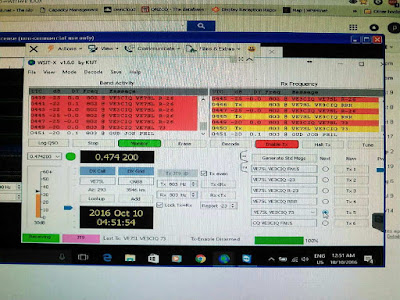 |
| Screen shot of QSO from VE3CIQ's end |
| VE3CIQ - 630m Station |
| VE3CIQ - Homebrew 630m Class-E Transmitter |
| VE3CIQ - 630m Linear-loaded Antenna |
Phil's station stands as yet another fine example of those living in the suburbs without a lot of room for antennas yet still able to successfully operate and explore our new 630m band. With a little ham-radio creativity, it's surprising how well a small station can perform, especially when the propagation co-operates.
Following our contact, I moved back to the WSPR section of the band and continued beaconing overnight.
Apparently Phil and I picked a good evening to run a sked as the overnight WSPR map shows it to have been the best night of the new DX season so far, with forty-four individual stations reporting my signal via the WSPRnet website.
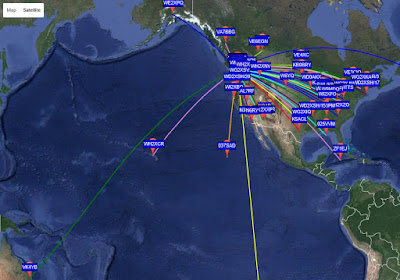 |
| courtesy: http://wsprnet.org/drupal/ |


